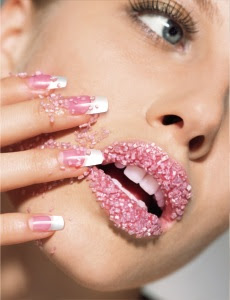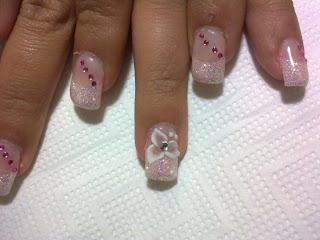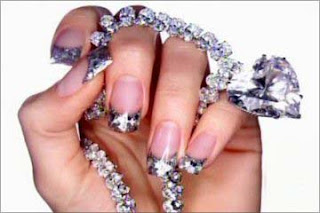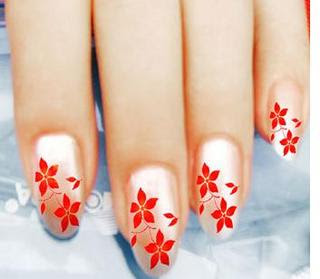Advantages of artificial nails:
offer variety of colors
customized to suit the taste of every woman
cover up short, brittle nails
don’t break or cur easily
prevent nail biting
long lasting and durable
polish lasts much longer
Disadvantages of artificial nails:
the chemicals used to make and adhere artificial nails may cause allergic reactions
if not applied and removed properly they may damage your natural nails
fungal or bacterial infection is possible
can be very expensive to maintain
most of the fake nails cannot be removed by chemicals
TYPES OF ARTIFICIAL NAILS:
Acrylic Nails
Acrylic nails, also known as artificial nails, fake nails, sculptured nails are the most used artificial nails. Acrylic nails should always be glued onto the natural nail plate. Acrylic nails are made of monomer (a liquid acrylic product) and a polymer (a powdered acrylic product). The artificial nails are the most preferred by the women as they are very durable and the strongest.
The application and the removal of acrylic nails takes a lot of practice and should always be performed by a licensed manicurist. You can have fake nails in any length and at any color that will last longer than nail polish on your natural nails. If you decide to get artificial nails you should know that they require a lot of maintenance – acrylic nails should be filled in every two/ three weeks as your nails grow. They are the strongest, the thickest and most durable of the artificial nails.
Many women think that artificial nails can seriously damage the natural nails but that’s not always the case – if the fake nails are applied and removed properly by a professional they may cause little or no damage to the natural nail plate.
Gel Nails
Gel nails are usually made of gel acrylic. Gel nails are appropriate for those women who want to achieve more natural look. The manicurist will apply the acrylic gel over your natural nail plate and will cure the gel under an ultraviolet light. Unfortunately the gel nails aren’t as strong and durable as the acrylic nails. There are two types of gel nails – the first use light and the other don’t. Both types of gel nails can be shaped and styles as you desire. One thing you should remember: gel nails cannot be removed easily – they must grow out and be filled down for removal.
One of the biggest advantage of gel nails is that they should be filled in less often then the acrylic nails for example.
Wrap Nails
Wrap nails usually include pieces of silk, linen, fiberglass or paper that are cut to the desired shape and then are glued to the natural nails. Just like the gel nails, wrap nails also look very natural as they are thin and smooth. Most of the beauty salons use fiberglass in place of silk or linen as it is stronger and provides a lot of flexibility. Unfortunately all types of wraps are less durable than the others. Wrap nails aren’t appropriate for those women with an active life as they break easily.
Solar Nails
Solar nails are similar to the acrylic nails but they use a different product – usually white or pink acrylic nails. Solar nails often look like a French manicure. Like the acrylic nails, the solar nails also should be refilled every three weeks.
Useful Tips:
Artificial nails should be filled in every two/ three weeks.
Always consult a manicurist to find out what type of fake nails will be best for you.
Always pay attention and moisturize your cuticles to avoid infection or dry cuticles.
Always wear rubber or plastic gloves every time you use chemicals.
It’s essential to apply nail and cuticle oil every day to keep your cuticles moisturized.
Remember: harsh chemicals may cause the artificial nails to weaken and even to discolor.
Never use household glue for nail repairs – you can seriously damage them.
Always choose a reputable, licensed nail salon to have your artificial nails applied properly.
Applying fake nails properly takes a lot of practice; if you decide to apply artificial nails at home always follow the directions written on the box to ensure you put them safely.
If you want to remove your fake nails at home you should use a nail soak – soak your fingers for approximately 30/ 40 minutes.
Never share your nail tools with another person and keep your tools (files, scissors) sanitized.
Never apply artificial nails on infected or irritated nails.
Never wear artificial nails for longer than 3/ 4 months to avoid damage.
Remember: the chemicals used to make and adhere fake nails can cause serious allergic reactions.
Always check if you have allergies before you get your nails done.
Remember: fungal infection is quite common if you don’t maintain your fake nails properly.
Never use Acetone nail polish remover.





No comments:
Post a Comment